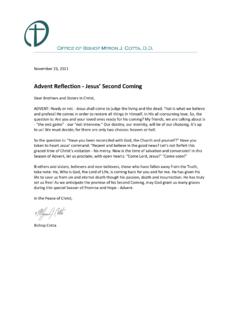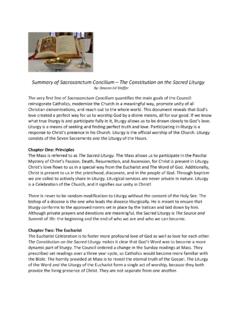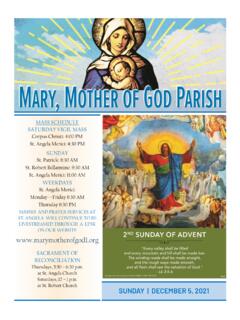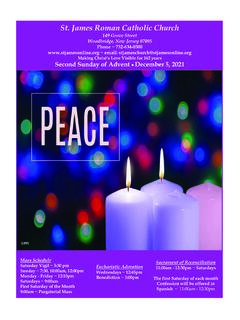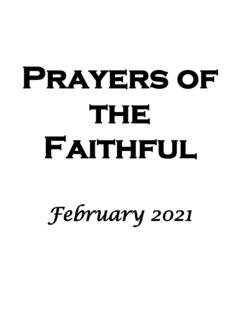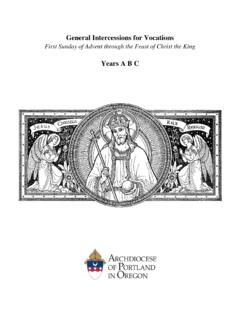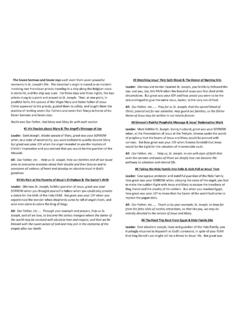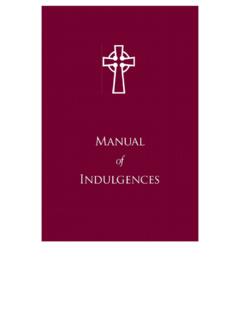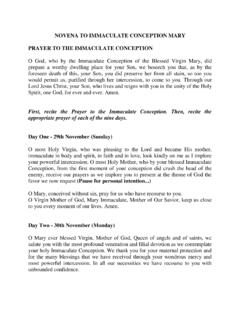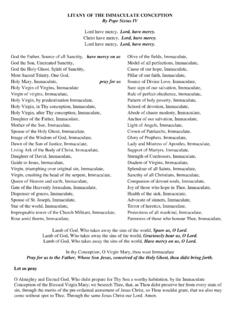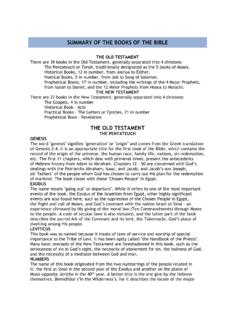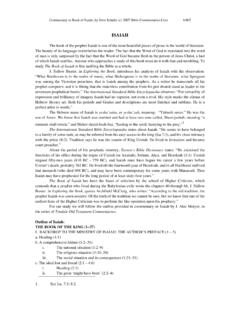Transcription of The Theology of the Body by John Paul II
1 John Paul II The Redemption of the body and Sacramentality of Marriage ( Theology of the body ) From the Weekly Audiences of His Holiness September 5, 1979 November 28, 1984 This work contains a series of 129 addresses delivered by Pope John Paul II during his Wednesday Audiences over a period of several years from September 5, 1979 November 28, 1984. Each of the addresses is related to the general theme now referred to as the Theology of the body and is included in this collection with with its original title. The date of each address is referenced in a footnote to the title. While the addresses are provided in chronological order, you will notice that there are often more than a one week difference in the dates between some consecutive titles in fact, you may find breaks of several weeks or months. This is because the Wednesday Audience schedule of the Pope varies according to the seasons of the Church year and summer holiday schedules.
2 Also, on occasion, John Paul II would postpone discussions of this topic in order to relay messages pertaining to other occasions, such as a series of reflections on the Holy Year. This collection includes all references that were available in the original publications. Where a reference clarified a particular word or passage, a footnote containing the reference information is inserted at the bottom of the page and the footnote is referenced with an Arabic numeral, such as 1, 2, or 3. Where the reference information provided an extensive discussion concerning an issue, but was not judged to be of immediate importance for purposes of understanding the particular word or passage, that reference information is included in the endnotes and is referenced with a Roman numeral, such as i, ii, or iii. Many references contain both types of information and will be divided between a footnote and an endnote.
3 In such cases, the reference will include both an Arabic and a Roman numeral, such as 1i . As stated above, the contents of this work is comprised of the audiences of Pope John Paul II. All rights to his works have been conveyed to the Vatican Library. While the works that were provided did not include a copyright notice, a copyright can be implied. Additionally, some of the works may have been included in the office newspaper of the Vatican, L'Osservatore Romano. While the works that were provided did not include a copyright notice, there is the potentiality of a copyright. Therefore, if this work is cited for academic purposes, please use the two copyright notices below. Copyright 2005 - Libreria Editrice Vaticana Copyright 1979- 1984 - L'Osservatore Romano _____ This electronic format prepared as a courtesy by The Catholic Primer Electronic Edition Copyright 2006 The Catholic Primer This electronic edition may be distributed free of charge provided that the contents are not altered and this copyright notice is included with the distributed copy, provided that the following conditions are adhered to.
4 This electronic document may not be offered in connection with any other document, product, promotion or other item that is sold, exchange for compensation of any type or manner, or used as a gift for contributions, including charitable contributions. Questions concerning this limited license should be directed to . This document may not be distributed in print form, except for educational, academic, pastoral, or ecclesiastical purposes that are performed in accordance with the ordinary Magisterium of the Catholic Church In honor and memory of Karol Wojtyla May 18, 1920 April 2, 2005 His Holiness Pope John Paul II October 16, 1978 April 2, 2005 Totus Tuus 2 CONTENTS The Unity and Indissolubility of Analysis of the Biblical Account of The Second Account of Creation: The Subjective Definition of The Boundary between Original Innocence and The Meaning of Man's Original Man's Awareness of Being a The Alternative between Death and Immortality Enters the Definition of The Original Unity of Man and By the Communion of Persons Man Becomes the Image of In the First Chapters of Genesis, Marriage Is One and The Meaning of Original Human The Fullness of Interpersonal Creation As a Fundamental and Original The Nuptial Meaning of the The Human Person Becomes a Gift in the Freedom of The Mystery of Man's Original Man and Woman.
5 A Gift for Each Original Innocence and Man's Historical Man Enters the World As a Subject of Truth and Analysis of Knowledge and of The Mystery of Woman Is Revealed in The Knowledge-Generation Cycle and the Perspective of Marriage in the Integral Vision of Christ Appeals to Man's The Ethical and Anthropological Content of the Commandment: "You Shall Not Commit Adultery"..63 Lust Is the Fruit of the Breach of the Covenant with Real Significance of Original A Fundamental Disquiet in All Human Relationship of Lust to Communion of Dominion over the Other in the Interpersonal Lust Limits Nuptial Meaning of the The Heart a Battlefield Between Love and Opposition in the Human Heart between the Spirit and the Sermon on the Mount to the Men of Our Day ..86 The Content of the Commandment: You Shall Not Commit Adultery According to the Law and as Spoken by the Adultery: A Breakdown of the Personal Meaning of Adultery Transferred from the body to the Concupiscence as a Separation From Matrimonial Significance of the Mutual Attraction Differs from Depersonalizing Effect of Establishing the Ethical 3 Interpreting the Concept of Gospel Values and Duties of the Human Realization of the Value of the body According to the Plan of the Power of Redeeming Completes Power of Eros and Ethos Meet and Bear Fruit in the Human Spontaneity: The Mature Result of Christ Calls Us to Rediscover the Living Forms of the New Purity of Justification in Opposition Between the Flesh and the Life in the Spirit Based on True St.
6 Paul's Teaching on the Sanctity and Respect of the Human St. Paul's Description of the body and Teaching on The Virtue of Purity Is the Expression and Fruit of Life According to the Spirit. 143 The Pauline Doctrine of Purity as Life According to the Positive Function of Purity of Pronouncements of Magisterium Apply Christ's Words The Human body , Subject of Works of Reflections on the Ethos of the Human body in Works of Artistic Art Must Not Violate the Right to Ethical Responsibilities in Marriage and Celibacy in the Light of the Resurrection of the The Living God Continually Renews the Very Reality of The Resurrection and Theological The Resurrection Perfects the Christ's Words on the Resurrection Complete the Revelation of the New Threshold of Complete Truth About Doctrine of the Resurrection according to St. The Risen body Will Be Incorruptible, Glorious, Full of Dynamism, and body 's Spiritualization Will Be Source of Its Power and Virginity or Celibacy for the Sake of the The Vocation to Continence in This Earthly Continence for the Sake of the Kingdom Meant to Have Spiritual The Effective and Privileged Way of The Superiority of Continence Does Not Devalue Marriage and Continence Complement Each The Value of Continence Is Found in Celibacy Is a Particular Response to the Love of the Divine Celibacy for the Kingdom Affirms Voluntary Continence Derives From a Counsel, Not From a The Unmarried Person Is Anxious to Please the Everyone Has His Own Gift from God, Suited to His The Kingdom of God, Not the World.
7 Is Man's Eternal Mystery of the body 's Redemption Basis of Teaching on Marriage and Voluntary 4 Marital Love Reflects God's Love for His The Call to Be Imitators of God and to Walk in Reverence for Christ the Basis of Relationship Between A Deeper Understanding of the Church and St Paul's Analogy of Union of Head and body Does Not Destroy Individuality of the Sacredness of Human body and Christ's Redemptive Love Has Spousal Moral Aspects of the Christian's The Relationship of Christ to the Church Connected With the Tradition of the Analogy of Spousal Love Indicates the Radical Character of Marriage Is the Central Point of the Sacrament of Loss of Original Sacrament Restored with Redemption in Marriage-Sacrament. 252 Marriage an Integral Part of New Sacramental Indissolubility of Sacrament of Marriage in Mystery of the Redemption of the Christ Opened Marriage to the Saving Action of Marriage Sacrament an Effective Sign of God's Saving The Redemptive and Spousal Dimensions of Language of the body , the Substratum and Content of the Sacramental Sign of Spousal The Language of the body in the Structure of The Sacramental Covenant in the Dimension of Language of the body Strengthens the Marriage Man Called to Overcome Return to the Subject of Human Love in the Divine Truth and Freedom the Foundation of True Love Is Ever Seeking and Never Love Is Victorious in the Struggle Between Good and The Language of the body .
8 Actions and Duties Forming the Spirituality of Morality of Marriage Act Determined by Nature of the Act and of the 291 The Norm of Humanae Vitae Arises from the Natural Law and the Revealed Importance of Harmonizing Human Love with Respect for Responsible Faithfulness to the Divine Plan in the Transmission of Church's Position on Transmission of A Discipline That Ennobles Human Responsible Parenthood Linked to Moral Prayer, Penance and the Eucharist Are Principal Sources of Spirituality for Married The Power of Love Is Given to Man and Woman as a Share in God's Continence Protects the Dignity of the Conjugal Continence Frees One from Inner 5 Continence Deepens Personal Christian Spirituality of Marriage Possible Only by Living According to the Respect for the Work of Conclusion to the Series on the Redemption of the body and Sacramentality of 6 The Unity and Indissolubility of Marriage1 For some time now preparations have been going on for the next ordinary assembly of the Synod of Bishops, which will take place in Rome in autumn of next year.
9 The theme of the Synod, "The role of the Christian family," concentrates our attention on this community of human and Christian life, which has been fundamental from the beginning. The Lord Jesus used precisely this expression "from the beginning" in the talk about marriage, reported in the Gospels of St. Matthew and St. Mark. We wish to raise the question what this word "beginning" means. We also wish to clarify why Christ referred to the "beginning" on that occasion and, therefore, we propose a more precise analysis of the relative text of Holy Scripture. During the talk with the Pharisees, who asked him the question about the indissolubility of marriage, Jesus Christ referred twice to the "beginning." The talk took place in the following way: "And Pharisees came up to him and tested him by asking, 'Is it lawful to divorce one's wife for any cause?
10 ' He answered, 'Have you not read that he who made them from the beginning made them male and female, and said, 'For this reason a man shall leave his father and mother and be joined to his wife, and the two shall become one flesh'? So they are no longer two but one flesh. What therefore God has joined together, let not man put asunder.' They said to him, 'Why then did Moses command one to give a certificate of divorce, and to put her away?' He said to them, 'For your hardness of heart Moses allowed you to divorce your wives, but from the beginning it was not so"' (Mt 19:3ff., cf. also Mk 10:2ff.). Christ did not accept the discussion at the level at which his interlocutors tried to introduce it. In a certain sense he did not approve of the dimension that they tried to give the problem. He avoided getting caught up in juridico-casuistical controversies.
